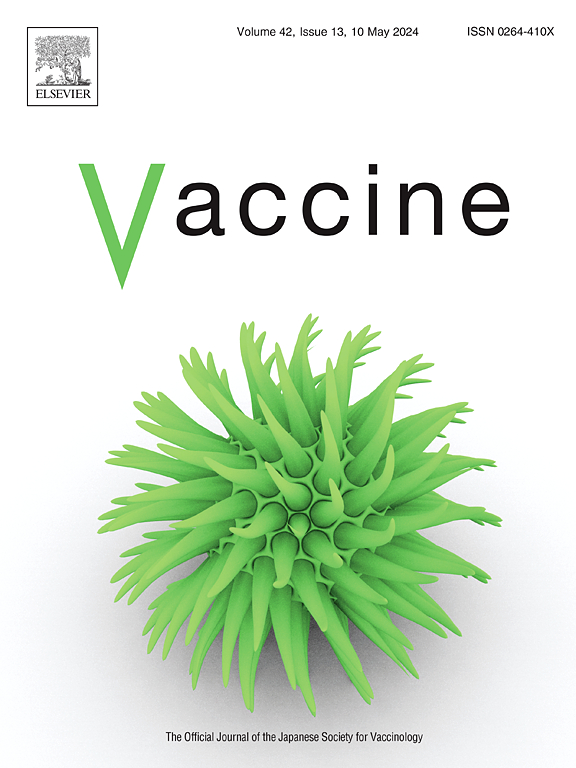Intussusception risk after rotavirus vaccination in Korean infants
IF 4.5
3区 医学
Q2 IMMUNOLOGY
引用次数: 0
Abstract
Introduction
An increased risk of intussusception after Rotavirus vaccination has been reported, with varying levels of risk associated with Rotarix and RotaTeq. This study evaluates the risk of intussusception following Rotarix and RotaTeq vaccination in Korean infants.
Methods
We performed a self-controlled case series study using vaccination registry from the Korea Disease Control and Prevention Agency and the National Health Insurance Service claims data. This study included infants aged less than one year who received at least one dose of Rotarix or RotaTeq within 8 months of birth between June 1, 2016, and December 31, 2022. An intussusception event was defined as the first hospitalization for intussusception. We defined the risk intervals as 1–7 days, 8–21 days, and 1–21 days post-vaccination and the observation period as from birth to one year. Conditional Poisson regression model was used to estimate the adjusted incidence rate ratio (aIRR) with adjustments for age effects by the monthly interval. The attributable risk was calculated using aIRR estimates and the estimated number of vaccine doses administered to the infants. Pseudo-likelihood methods accounted for the potential contraindication to vaccination after intussusception.
Results
Among 786,977 infants receiving Rotarix, 764 intussusception cases occurred, while 751 cases were identified among 800,232 infants who received RotaTeq. For Rotarix, the IRR during the 1–7 day risk intervals after the first dose was 3.15 (95 % confidence interval [CI] 1.54–6.44) with an attributable risk of 2.17 (95 % CI 1.11–2.68) per 100,000 doses and an absolute risk of 3.18 per 100,000 doses. No significant increase in intussusception risk was observed for RotaTeq across all risk intervals.
Conclusions
The risk of intussusception increased within 7 days after the first dose of Rotarix vaccination, while no significant evidence of an increased risk was observed after RotaTeq vaccination.
韩国婴儿接种轮状病毒后肠套叠的风险
据报道,轮状病毒疫苗接种后肠套叠的风险增加,与rottarix和RotaTeq相关的风险程度不同。本研究评估韩国婴儿接种Rotarix和RotaTeq疫苗后肠套叠的风险。方法采用韩国疾病预防控制院的疫苗接种登记和国民健康保险服务机构的索赔数据进行了自我控制的病例系列研究。该研究包括在2016年6月1日至2022年12月31日期间出生的8个月内接受至少一剂Rotarix或RotaTeq的一岁以下婴儿。肠套叠事件定义为首次因肠套叠住院。我们定义接种后1-7天、8-21天和1-21天为危险间隔,观察期为出生至1年。采用条件泊松回归模型估计经月间隔调整年龄效应后的调整发病率比(aIRR)。归因风险是使用aIRR估计值和婴儿接种疫苗剂量估计值来计算的。伪似然方法解释了肠套叠后接种疫苗的潜在禁忌症。结果768977例患儿中出现764例肠套叠,800232例患儿中出现751例肠套叠。对于Rotarix,首次剂量后1-7天风险区间内的IRR为3.15(95%置信区间[CI] 1.54-6.44),归因风险为2.17 (95% CI 1.11-2.68) / 100,000剂量,绝对风险为3.18 / 100,000剂量。在所有风险区间内,RotaTeq均未观察到肠套叠风险的显著增加。结论首次接种RotaTeq疫苗后7天内肠套叠的风险增加,而接种RotaTeq疫苗后未观察到风险增加的显著证据。
本文章由计算机程序翻译,如有差异,请以英文原文为准。
求助全文
约1分钟内获得全文
求助全文
来源期刊

Vaccine
医学-免疫学
CiteScore
8.70
自引率
5.50%
发文量
992
审稿时长
131 days
期刊介绍:
Vaccine is unique in publishing the highest quality science across all disciplines relevant to the field of vaccinology - all original article submissions across basic and clinical research, vaccine manufacturing, history, public policy, behavioral science and ethics, social sciences, safety, and many other related areas are welcomed. The submission categories as given in the Guide for Authors indicate where we receive the most papers. Papers outside these major areas are also welcome and authors are encouraged to contact us with specific questions.
 求助内容:
求助内容: 应助结果提醒方式:
应助结果提醒方式:


